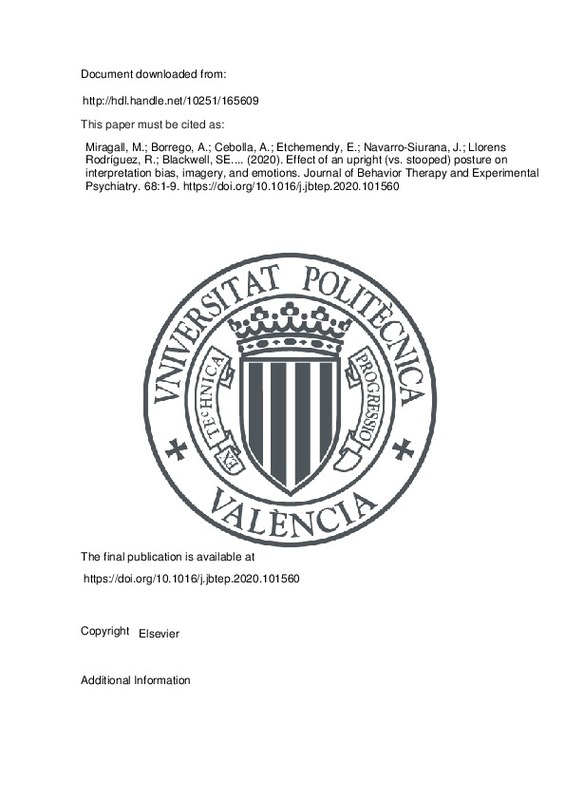Barnard, P. J., & Teasdale, J. D. (1991). Interacting cognitive subsystems: A systemic approach to cognitive-affective interaction and change. Cognition & Emotion, 5(1), 1-39. doi:10.1080/02699939108411021
Barsalou, L. W. (2008). Grounded Cognition. Annual Review of Psychology, 59(1), 617-645. doi:10.1146/annurev.psych.59.103006.093639
Blackwell, S. E., Browning, M., Mathews, A., Pictet, A., Welch, J., Davies, J., … Holmes, E. A. (2015). Positive Imagery-Based Cognitive Bias Modification as a Web-Based Treatment Tool for Depressed Adults. Clinical Psychological Science, 3(1), 91-111. doi:10.1177/2167702614560746
[+]
Barnard, P. J., & Teasdale, J. D. (1991). Interacting cognitive subsystems: A systemic approach to cognitive-affective interaction and change. Cognition & Emotion, 5(1), 1-39. doi:10.1080/02699939108411021
Barsalou, L. W. (2008). Grounded Cognition. Annual Review of Psychology, 59(1), 617-645. doi:10.1146/annurev.psych.59.103006.093639
Blackwell, S. E., Browning, M., Mathews, A., Pictet, A., Welch, J., Davies, J., … Holmes, E. A. (2015). Positive Imagery-Based Cognitive Bias Modification as a Web-Based Treatment Tool for Depressed Adults. Clinical Psychological Science, 3(1), 91-111. doi:10.1177/2167702614560746
Blackwell, S. E., & Holmes, E. A. (2010). Modifying interpretation and imagination in clinical depression: A single case series using cognitive bias modification. Applied Cognitive Psychology, 24(3), 338-350. doi:10.1002/acp.1680
Blackwell, S. E., Westermann, K., Woud, M. L., Cwik, J. C., Neher, T., Graz, C., … Margraf, J. (2018). Computerized positive mental imagery training versus cognitive control training versus treatment as usual in inpatient mental health settings: study protocol for a randomized controlled feasibility trial. Pilot and Feasibility Studies, 4(1). doi:10.1186/s40814-018-0325-1
Carney, D. R., Cuddy, A. J. C., & Yap, A. J. (2010). Power Posing. Psychological Science, 21(10), 1363-1368. doi:10.1177/0956797610383437
Cuddy, A. J. C., Schultz, S. J., & Fosse, N. E. (2018). P-Curving a More Comprehensive Body of Research on Postural Feedback Reveals Clear Evidential Value for Power-Posing Effects: Reply to Simmons and Simonsohn (2017). Psychological Science, 29(4), 656-666. doi:10.1177/0956797617746749
Cuddy, A. J. C., Wilmuth, C. A., Yap, A. J., & Carney, D. R. (2015). Preparatory power posing affects nonverbal presence and job interview performance. Journal of Applied Psychology, 100(4), 1286-1295. doi:10.1037/a0038543
Everaert, J., Koster, E. H. W., & Derakshan, N. (2012). The combined cognitive bias hypothesis in depression. Clinical Psychology Review, 32(5), 413-424. doi:10.1016/j.cpr.2012.04.003
Everaert, J., Podina, I. R., & Koster, E. H. W. (2017). A comprehensive meta-analysis of interpretation biases in depression. Clinical Psychology Review, 58, 33-48. doi:10.1016/j.cpr.2017.09.005
Faul, F., Erdfelder, E., Lang, A.-G., & Buchner, A. (2007). G*Power 3: A flexible statistical power analysis program for the social, behavioral, and biomedical sciences. Behavior Research Methods, 39(2), 175-191. doi:10.3758/bf03193146
Gotlib, I. H., & Joormann, J. (2010). Cognition and Depression: Current Status and Future Directions. Annual Review of Clinical Psychology, 6(1), 285-312. doi:10.1146/annurev.clinpsy.121208.131305
Holmes, E. A., Blackwell, S. E., Burnett Heyes, S., Renner, F., & Raes, F. (2016). Mental Imagery in Depression: Phenomenology, Potential Mechanisms, and Treatment Implications. Annual Review of Clinical Psychology, 12(1), 249-280. doi:10.1146/annurev-clinpsy-021815-092925
Holmes, E. A., Lang, T. J., & Deeprose, C. (2009). Mental Imagery and Emotion in Treatment across Disorders: Using the Example of Depression. Cognitive Behaviour Therapy, 38(sup1), 21-28. doi:10.1080/16506070902980729
Holmes, E. A., Lang, T. J., Moulds, M. L., & Steele, A. M. (2008). Prospective and positive mental imagery deficits in dysphoria. Behaviour Research and Therapy, 46(8), 976-981. doi:10.1016/j.brat.2008.04.009
Ingram, R. E. (1984). Toward an information-processing analysis of depression. Cognitive Therapy and Research, 8(5), 443-477. doi:10.1007/bf01173284
Joormann, J., Yoon, K. L., & Zetsche, U. (2007). Cognitive inhibition in depression. Applied and Preventive Psychology, 12(3), 128-139. doi:10.1016/j.appsy.2007.09.002
Körner, A., Topolinski, S., & Strack, F. (2015). Routes to embodiment. Frontiers in Psychology, 6. doi:10.3389/fpsyg.2015.00940
LeMoult, J., & Gotlib, I. H. (2019). Depression: A cognitive perspective. Clinical Psychology Review, 69, 51-66. doi:10.1016/j.cpr.2018.06.008
Mathews, A., & MacLeod, C. (2005). Cognitive Vulnerability to Emotional Disorders. Annual Review of Clinical Psychology, 1(1), 167-195. doi:10.1146/annurev.clinpsy.1.102803.143916
Nair, S., Sagar, M., Sollers, J., Consedine, N., & Broadbent, E. (2015). Do slumped and upright postures affect stress responses? A randomized trial. Health Psychology, 34(6), 632-641. doi:10.1037/hea0000146
Niedenthal, P. M. (2007). Embodying Emotion. Science, 316(5827), 1002-1005. doi:10.1126/science.1136930
Platt, B., Waters, A. M., Schulte-Koerne, G., Engelmann, L., & Salemink, E. (2016). A review of cognitive biases in youth depression: attention, interpretation and memory. Cognition and Emotion, 31(3), 462-483. doi:10.1080/02699931.2015.1127215
Rohrbacher, H., & Reinecke, A. (2014). Measuring Change in Depression-Related Interpretation Bias: Development and Validation of a Parallel Ambiguous Scenarios Test. Cognitive Behaviour Therapy, 43(3), 239-250. doi:10.1080/16506073.2014.919605
Stöber, J. (2000). Prospective cognitions in anxiety and depression: Replication and methodological extension. Cognition & Emotion, 14(5), 725-729. doi:10.1080/02699930050117693
Teasdale, J. D., Segal, Z., & Williams, J. M. G. (1995). How does cognitive therapy prevent depressive relapse and why should attentional control (mindfulness) training help? Behaviour Research and Therapy, 33(1), 25-39. doi:10.1016/0005-7967(94)e0011-7
Tsai, H.-Y., Peper, E., & Lin, I.-M. (2016). EEG patterns under positive/negative body postures and emotion recall tasks. NeuroRegulation, 3(1), 23-27. doi:10.15540/nr.3.1.23
Veenstra, L., Schneider, I. K., & Koole, S. L. (2016). Embodied mood regulation: the impact of body posture on mood recovery, negative thoughts, and mood-congruent recall. Cognition and Emotion, 31(7), 1361-1376. doi:10.1080/02699931.2016.1225003
Watson, D., Clark, L. A., & Tellegen, A. (1988). Development and validation of brief measures of positive and negative affect: The PANAS scales. Journal of Personality and Social Psychology, 54(6), 1063-1070. doi:10.1037/0022-3514.54.6.1063
Wilkes, C., Kydd, R., Sagar, M., & Broadbent, E. (2017). Upright posture improves affect and fatigue in people with depressive symptoms. Journal of Behavior Therapy and Experimental Psychiatry, 54, 143-149. doi:10.1016/j.jbtep.2016.07.015
Wilson, V. E., & Peper, E. (2004). The Effects of Upright and Slumped Postures on the Recall of Positive and Negative Thoughts. Applied Psychophysiology and Biofeedback, 29(3), 189-195. doi:10.1023/b:apbi.0000039057.32963.34
[-]







![[Cerrado]](/themes/UPV/images/candado.png)


